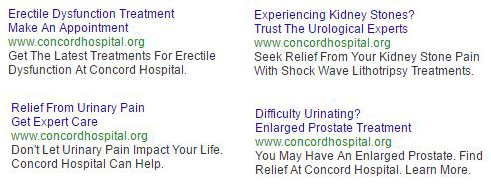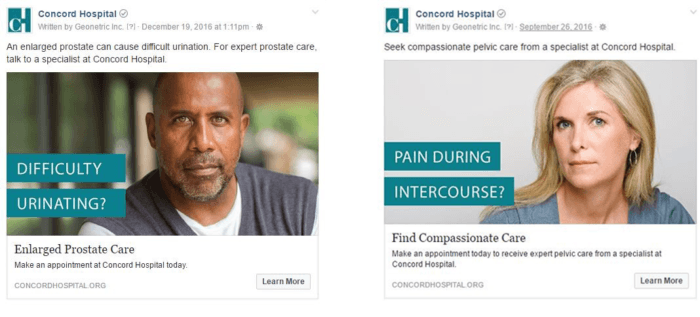
“We are very pleased with the campaign results and the work Geonetric performed to help make it a success.”
Jenn Dearborn, Web Manager
Concord Hospital
Concord Hospital’s Center for Urologic Care ranks in the top seven percent nationwide in patient satisfaction surveys (Press Ganey). With scores like that, Concord Hospital’s marketing team wanted to spread the word. They partnered with Geonetric to reach health consumers in Concord, NH and the surrounding areas with a three-month PPC campaign.
The campaign focused on growing service line volume and increasing visibility outside their primary service area. To achieve their goals, our team worked through our five-step process for PPC campaigns: conceive, develop, implement, analyze, and test.
Conceive
We began by learning about Concord Hospital’s urology services, specialized programs, and the benefits to patients. After we understood Concord Hospital’s services, we imagined the types of people affected by different conditions—their age, gender, and topics that interest them. The campaign focused on conditions including:
- Enlarged prostate
- Prostate cancer
- Erectile dysfunction
- Incontinence
- Kidney stones
- Pelvic pain
We conducted keyword research for each condition. Our team searched for keywords that had high traffic and provided good value.
In addition to the PPC work, we talked with Concord Hospital’s marketing team about the conversion journey to provide a larger context for the campaign and recommend best-practices. We discussed the importance of making each step easy for potential patients and provided advice on which landing pages to set up for the ads. These discussions helped establish a consistent user experience throughout the conversion journey, from seeing the PPC ad to requesting an appointment.
Develop
The keyword research informed the development of text ads in Google and Bing. Our team focused the ad copy on patients’ needs and highlighted the benefits of the Center for Urologic Care.
In addition, we used dynamic keyword insertion to personalize the ads. By including brackets { } in the text ads, Google and Bing pull the keyword that triggered the ad. While we control which keywords can appear through a target keyword list, it adds a personal touch that makes the ads more relevant to users.
We also developed display ads, working collaboratively with Concord Hospital’s team to choose the right images and copy.
Implement
We implemented text ads on Google and Bing. We also launched display ads on Twitter, Facebook, and Google (see examples).

Analyze
After the launch, we began analyzing the data. We monitored traffic and conversions generated by the ads. Our team reviewed the campaign’s performance on an ongoing basis and optimized targeting and budget for the keywords, ads, and platforms that performed best. For example, we paid attention to the keywords that got better results, such as “Erectile Dysfunction” or “E.D.”
While we made small adjustments throughout the entire campaign, we made major recommendations in monthly meetings where we delivered a monthly performance report. Major changes included shifts in platforms and changes to the ads themselves.
Platform Shifts
From the beginning, we identified Twitter as the lowest performing platform. The click-through-rate (CTR) was low for industry averages. For the people who did convert, they spent very little time on the landing page. After a month, we ended the Twitter ads and shifted the ad spend to Facebook, which was performing well.
While Google performed well in the beginning, Bing improved over time. By the end of the second month, we decided to shift some ad spend from Google to Bing to increase ROI.
Ad Changes
In addition to monitoring the general performance on each platform, we examined the performance of individual ads and ad groups. For example, between months two and three, we made enhancements to the kidney stone text ads to optimize the keywords. We also made changes to display ads, such as swapping genders in some images and improving the ad copy (see examples).


Test
We tested the results of each change we made. Here’s some highlights:
- The decision to end Twitter ads and move that ad spend to Facebook paid off. In the remaining months, Facebook’s CTR was three times higher at 2.99 percent, with the cost-per-click being almost half as much. By making the switch, Concord Hospital increased traffic at a lower cost.
- While Google outperformed Bing in the first month in CTR and number of clicks, Bing surpassed Google in the last month. While the CTR was about equal, Bing brought in over twice the traffic with a cost-per-click that was 27 percent lower. Bing reached the right people, which helped increase traffic and appointment requests.
- By optimizing the copy for the kidney stone text ad group, the CTR doubled. Swapping the image for the kidney stone display ad improved number of clicks and average CTR.
Conclusion
The campaign ran for three months. The ads drove 9,570 visits to their site, and resulted in 17 appointment requests. The ads raised awareness for the Center for Urologic Care and generated new revenue.
PPC Campaign Attracts New Patients








